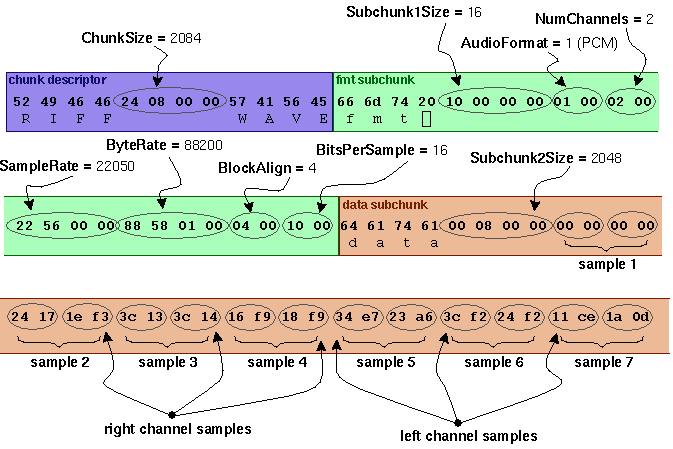PCM WAVE格式詳解及用C語言實現wave檔案的讀取
1.PCM Wave格式詳解
WAVE檔案格式是微軟RIFF(Resource Interchange File Format,資源交換檔案標準)的一種,是針對於多媒體檔案儲存的一種檔案格式和標準。 一般而言,RIFF檔案由檔案頭和資料兩部分組成,一個WAVE檔案由一個“WAVE”資料塊組成,這個“WAVE”塊又由一個”fmt”子資料塊和一個“data”子 資料塊組成,也稱這種格式為“Canonical form”(權威/牧師格式),如下圖所示:

每個欄位的涵義如下: ChunkID: 佔4個位元組,內容為“RIFF”的ASCII碼(0x52494646),以大端(big endian)儲存。
ChunkSize: 4位元組,儲存整個檔案的位元組數(不包含ChunkID和ChunkSize這8個位元組),以小端(little endian)方式儲存。
Format: 4位元組,內容為“WAVE”的ASCII碼(0x57415645),以大端儲存。
其中bigendian 主要有一個特徵,在記憶體中對運算元的儲存方式和從高位元組到低位元組。例如:0x1234,這樣一個數,儲存為:
0x4000: 0x12
0x4001: 0x34
而小尾端littleendian是:
0x4000: 0x34
0x4001: 0x12
用程式在區別的話,可以考慮:
1 2 3 4 5 6 7 8 9 10 11 12 13 14 15 |
|
“WAVE”格式由兩個子資料塊構成:“fmt”塊和“data”塊,其中“fmt”塊的詳細解釋如下: Subchunk1ID: 佔4個位元組,內容為“fmt ”的ASCII碼(0x666d7420),以大端儲存。
Subchunk1Size: 佔4個位元組,儲存該子塊的位元組數(不含前面的Subchunk1ID和Subchunk1Size這8個位元組),以小端方式儲存。
AudioFormat:佔2個位元組,以小端方式儲存,儲存音訊檔案的編碼格式,例如若為PCM則其儲存值為1,若為其他非PCM格式的則有一定的壓縮。
NumChannels: 佔2個位元組,以小端方式儲存,通道數,單通道(Mono)值為1,雙通道(Stereo)值為2,等等。
SampleRate: 佔4個位元組,以小端方式儲存,取樣率,如8k,44.1k等。
ByteRate: 佔4個位元組,以小端方式儲存,每秒儲存的bit數,其值=SampleRate * NumChannels * BitsPerSample/8
BlockAlign: 佔2個位元組,以小端方式儲存,塊對齊大小,其值=NumChannels * BitsPerSample/8
BitsPerSample: 佔2個位元組,以小端方式儲存,每個取樣點的bit數,一般為8,16,32等。
接下來是兩個可選的擴充套件引數:
ExtraParamSize: 佔2個位元組,表示擴充套件段的大小。
ExtraParams: 擴充套件段其他自定義的一些引數的具體內容,大小由前一個欄位給定。
其中,對於每個取樣點的bit數,不同的bit數讀取資料的方式不同:
1 2 3 4 5 6 7 8 9 10 |
|
“WAVE”格式檔案的第二個子資料塊是“data”,其個欄位的詳細解釋如下:
Subchunk2ID: 佔4個位元組,內容為“data”的ASCII碼(0x64617461),以大端儲存。
Subchunk2Size: 佔4個位元組,內容為接下來的正式的資料部分的位元組數,其值=NumSamples * NumChannels * BitsPerSample/8
Data: 真正的語音資料部分。
一個Wave檔案頭的例項
設一個wave檔案的前72個位元組的十六進位制內容如下(可以使用Ultra Edit等工具檢視wave檔案頭):
1 2 3 |
|

C語言實現wave檔案的讀取
這裡給出一個用基本的C語言檔案操作庫函式實現的Wave檔案讀取的例項程式碼,可以跨Windows和Linux平臺。
1 2 3 4 5 6 7 8 9 10 11 12 13 14 15 16 17 18 19 20 21 22 23 24 25 26 27 28 29 30 31 32 33 34 35 36 37 38 39 40 41 42 43 44 45 46 47 48 49 50 51 52 53 54 55 56 57 58 59 60 61 62 63 64 65 66 67 68 69 70 71 72 73 74 75 76 77 78 79 |
|
參考
[1]WAVE PCM soundfile format: https://ccrma.stanford.edu/courses/422/projects/WaveFormat/
[2]Resource Interchange File Format: http://en.wikipedia.org/wiki/Resource_Interchange_File_Format
[3]基於Visual C++6.0的聲音檔案操作: http://www.yesky.com/20030414/1663116_1.shtml
